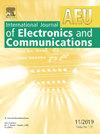Reconfigurable intelligent surface-assisted AFDM for high-mobility communications
IF 3.2
3区 计算机科学
Q2 ENGINEERING, ELECTRICAL & ELECTRONIC
Aeu-International Journal of Electronics and Communications
Pub Date : 2025-08-25
DOI:10.1016/j.aeue.2025.156009
引用次数: 0
Abstract
To overcome the large Doppler shift in high-mobility communications, affine frequency division multiplexing (AFDM) has recently emerged as a promising alternative to orthogonal frequency division multiplexing (OFDM). By employing the discrete affine Fourier transform, AFDM effectively mitigates time–frequency doubly selective fading and outperforms OFDM in high-Doppler scenarios. Meanwhile, reconfigurable intelligent surfaces (RIS) have also gained attention as a transformative technology for enhancing communication performance under mobility. To further improve the bit error rate (BER) performance, we propose an RIS-assisted AFDM system tailored for high-mobility settings. We first derive the input–output relations of the system in both the time and discrete affine Fourier domains. Next, the system is extended to a multiple-input multiple-output model. Then, we present an RIS phase-shift design method to maximize the signal-to-noise ratio at the receiver. Finally, we evaluate the influence of critical system parameters such as the number of RIS units, phase optimization methods, channel conditions, and antenna configurations on the system’s performance in doubly dispersive channels. Simulation results demonstrate that the proposed optimization method yields a substantial improvement in BER performance over random phase optimization. Furthermore, the proposed RIS-assisted AFDM system achieves significantly lower BER compared to both RIS-OFDM and conventional AFDM systems in doubly dispersive channels.
用于高移动性通信的可重构智能表面辅助AFDM
为了克服高迁移率通信中的大多普勒频移,仿射频分复用(AFDM)最近成为正交频分复用(OFDM)的一个有前途的替代方案。通过采用离散仿射傅里叶变换,AFDM有效地减轻了时频双选择性衰落,在高多普勒情况下优于OFDM。与此同时,可重构智能表面(RIS)作为一种提高移动通信性能的变革性技术也受到了人们的关注。为了进一步提高误码率(BER)性能,我们提出了一种适合高移动性设置的ris辅助AFDM系统。我们首先推导了系统在时间和离散仿射傅里叶域中的输入输出关系。其次,将系统扩展为多输入多输出模型。然后,我们提出了一种RIS相移设计方法,以最大化接收机的信噪比。最后,我们评估了关键系统参数(如RIS单元数量、相位优化方法、信道条件和天线配置)对系统在双色散信道中的性能的影响。仿真结果表明,与随机相位优化相比,所提出的优化方法在误码率性能上有很大的提高。此外,与RIS-OFDM和传统AFDM系统相比,本文提出的ris辅助AFDM系统在双频散信道下的误码率显著降低。
本文章由计算机程序翻译,如有差异,请以英文原文为准。
求助全文
约1分钟内获得全文
求助全文
来源期刊
CiteScore
6.90
自引率
18.80%
发文量
292
审稿时长
4.9 months
期刊介绍:
AEÜ is an international scientific journal which publishes both original works and invited tutorials. The journal''s scope covers all aspects of theory and design of circuits, systems and devices for electronics, signal processing, and communication, including:
signal and system theory, digital signal processing
network theory and circuit design
information theory, communication theory and techniques, modulation, source and channel coding
switching theory and techniques, communication protocols
optical communications
microwave theory and techniques, radar, sonar
antennas, wave propagation
AEÜ publishes full papers and letters with very short turn around time but a high standard review process. Review cycles are typically finished within twelve weeks by application of modern electronic communication facilities.

 求助内容:
求助内容: 应助结果提醒方式:
应助结果提醒方式:


